Safira Carvalho, Food Researcher, Agora Food Studio
These food stories were told to Safira by Avo Joana Guterres from Caicoli, Venilale. It was an amazing opportunity for Agora’s Food Researcher to interview Avo Joana about her experiences of using survival foods and to write this story about Maek, Kali’i, Lehe and Uhi. The descriptions of the foods include the story of planting, harvesting and eating. Agora Food Studio is promoting local food products that are being lost from Timor-Leste because they are not being cooking any more by people in the community.
Maek
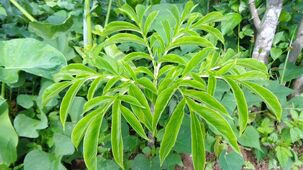
Maek is a historical survival food used when the Portuguese, Japanese and Indonesians colonised and
invaded East Timor. During the resistance fighting, many people including elders, youth and children didn’t survive because they didn’t have enough food.
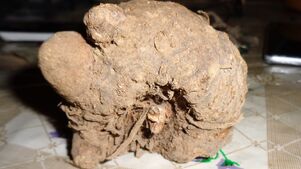
Maek was a wild food and many people didn’t realize that it can be eaten. Some Timorese fighters tried to eat it because there was not enough food for them in the forest. They realized Maek was edible and could be used as a survival food.
Avo Joana Guterres from Caicoli, Venilale told me that “Maek was a food that people ate to survive”. During the war, Avo Joana and her family only ate Maek and some other hidden foods such as Lehe and Kali’i. She said that “it was an unforgettable experienced and she only survived because of the previously unknown foods like Maek”.
Maek in Mediki language is called Bau. Actually, Maek has two types which are:
-Edible Maek
-Wild Maek
Edible Maek is grown in the garden and is planted by the gardener when it’s in season. It has a lighter stem with white and green colours on it. The edible tuber is harvested and eaten. When it is cooked and boiled, its flavour is like sweet potato mash and it doesn’t create any itchiness in the mouth.
Wild Maek grows everywhere in the forest except in very wet areas. It has a different stem to the edible one and it can make the mouth itchy unless it is cooked in a proper way.
Maek is planted in the dry season after the rice is harvested. Maek is planted in August or September and starts to grow when the rains come in November. After harvesting the farmers take the Maek home. The Maek is boiled and roasted and used as a breakfast food by the farmers.
It was interesting to hear Avo Joana telling the story about that food. She said that “Maek always has an important role in their rice harvesting ceremony because they cook it with Kali’i, Lehe and Uhi to serve to the people that attend. The ceremony in Tetum is called the = “Serimonia de Sama Haré”. Only a few people come to join the ceremony now and sadly it is becoming a lost tradition.
Lehe
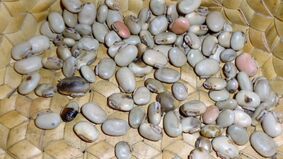
Lehe is a survival food used by Avo Joana Guterres from Venilale, Caicoi. In the Midiki language, Lehe is
called “Utawa’a” and in the Makasae language is called “Gala”. Lehe is a type of bean that grows during the time of corn planting in the rainy season. It always grows together with corns, beans, and pumpkin in the garden in the rainy season during November or December. Lehe is harvested at the same time as the corn crop in April or May. It is a traditional crop used by the ancestors until now.
Once the crops are harvested, the farmers bring some to the Holy House or “Uma Lulik”. Everyone has to make an offering at the Uma Lulik otherwise they cannot have good growth of corn and lehe. This tradition is called “Sau-batar” and it honours the holy things around us and protects us from the bad things that could happen to us. This is part of our cultural heritage transmitted from the ancestors.
Kali'i
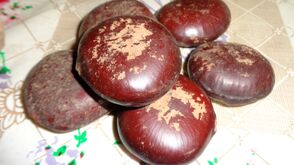
Kali’i is a survival food that takes a long process to cook to make it edible. In Midiki language, Kali’i is called “Heni-Wai” and it is a wild food that grows in the forest or rocky areas. It is a vine that climbs up trees and rocks.
Kali’i is an amazing and inspiring food for Avo Joana and her family. During the war, Kali’i was an new food for Avo Joana. Her ancestors didn’t use it for food. When the war was on and food was scarce, the resistance fighters tried to eat Kali’i for the first time. The Timorese fighters were the only people that knew how to eat and cook the Kali’i. When they had detected the food was really amazing and tasty, they told the people that didn’t have enough food to try eating it. After they heard about Kali’I from the fighters, the people tried eating it because they were really hungry at that time.
Kali’i starts growing in rainy season in the month of November and it flowers and fruits in January. The process of getting good fruit takes three months. When the dry season comes the seed pods fall to the ground in May or June. At this time people went to collect the seeds from the ground.
Uhi
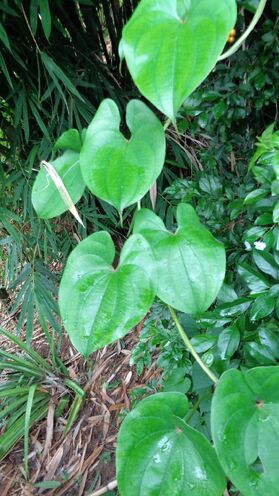
Uhi has a story which is pretty similar to the other survival foods of Maek, Kali’i and Lehe. In Midiki language Uhi is called K’ilu, which is a food that grows underground. It starts growing in September and into the rainy season in November and December. The plants start to grow up and climb into some trees and vegetables that grow in the garden.
The farmers harvest once a year in June or July. People prefer to boil Uhi and to use it for their breakfast and for takeaway food. Uhi is paired with pumpkin and sweet potato leaf because it is really good for carrying by yourself when you are away at the farm or travelling. This is a tradition that many people keep doing today.
These foods remind the young generation about the traditions of the past. These foods were valuable for many people during the war. They ate these foods because they were hungry and suffering. Nowadays, the young generation need to know the history about their local food because it is part of their identity. Once we have heard this information we can keep and value our local products in Timor.
Avo Joana said “please tell people about our experience using the local foods we had and how we survived on these foods. Now it is your time to promote these stories for everyone because you are the young generation responsible for promoting Timor’s foods”.